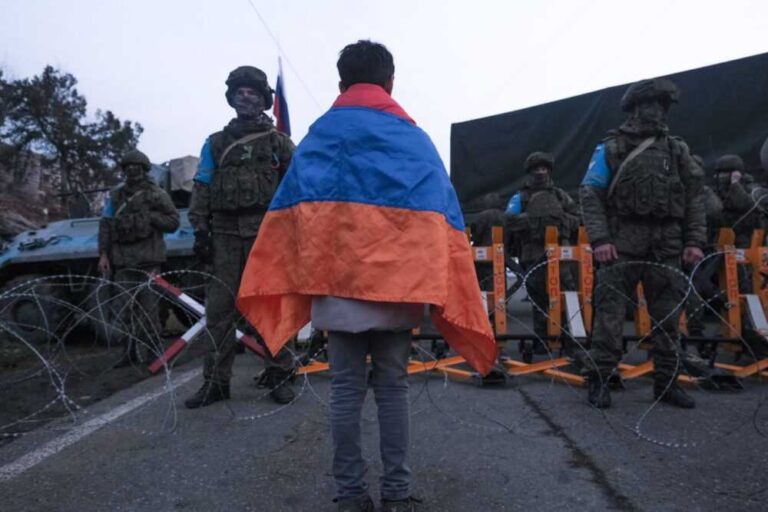ARMENIA/NAGORNO-KARABAKH BORDER– The road to Nagorno-Karabakh stands nearly empty. The crossing point from Armenia, usually bustling with vehicles on a Thursday afternoon, instead hosts just a handful of cars and a couple of downtrodden border guards. “It’s been like this for a month and a half now,” Tigran, one of the Armenian servicemen at the checkpoint, tells Paradox. “If you had the proper permission from Yerevan, we could let you go on, but you’d just get stopped at the first Russian checkpoint anyways. There’s no point going further,” he says, gesturing at the desolate mountains in the background.
Just 30 kilometers further lies Stepanakert, the capital of the unrecognized Republic of Artsakh, also known as Nagorno-Karabakh. These days, it might as well be across the ocean. For nearly two months, the only road connecting the territory to Armenia – and to the outside world – has been closed by Azerbaijani state-backed protesters, leaving over 100,000 people stranded without enough food, gas or electricity.
The conflict over Nagorno-Karabakh has been playing out for more than three decades now, though has reached a boiling point these past few months with the imposition of the blockade. As the Soviet Union began to crumble in the late 1980s, the region’s ethnic Armenian inhabitants demanded that their autonomous region be transferred out of Soviet Azerbaijan (to which it belonged) and joined to Soviet Armenia. Tensions spiraled into full-scale war, ending in victory for Karabakh forces (backed by Armenia) in 1994. After decades of failed negotiations and an oil-fueled military spending spree, Azerbaijan struck back in 2020: through 44 days of intense warfare, Azerbaijani troops captured much of the region. Russia brokered a ceasefire, and 2,000 Russian officials entered the remaining Armenian-held parts of Karabakh to prevent further violence from breaking out.
But a ceasefire is not peace, and Azerbaijan wanted more. Azerbaijani President Ilham Aliyev has set his sights on reclaiming the entirety of Nagorno-Karabakh, and over the past two years has tried numerous tactics to seize more parts of the territory and induce its residents to bend the knee or leave. On December 11th, Azerbaijan tried a new scheme: a group of Azerbaijani activists, ostensibly protesting ecological damage inflicted by Karabakh Armenians, set up camp on the only road connecting Nagorno-Karabakh with Armenia. With the exception of a handful of Red Cross and Russian vehicles, no traffic has gone in or out of the besieged enclave for nearly two months. As Russian troops have looked on, the residents of Karabakh have been reduced to food rationing and subjected to frequent blackouts and fuel shortages.
Those who were outside Nagorno-Karabakh when the blockade started, meanwhile, have been stranded.
Armine Aghajanyan, 32, sits in a hotel in the city of Goris, the last major Armenian town before the border and the road to Karabakh. Her two daughters, 10-year old Greta and eight-year old Anzhelina, are playing with other local children outside.

Aghajanyan had taken her elder daughter to Yerevan, Armenia’s capital, for a dance program on December 10. They were returning to Karabakh’s capital Stepanakert the next day when they learned of the blockade.
“We were halfway to Karabakh when we heard the road was closed,” Aghajanyan says. “We came to Goris for what we thought would be just one night. Clearly, we were wrong,” she says.
Aghajanyan’s husband remains in Karabakh: A taxi driver, he is one of thousands of residents now out of work as a result of the blockade. With little fuel to go around, he is unable to fill his vehicle.
Their kids are coping well enough, but the extended absence from home – especially over the holiday period – is beginning to take its toll.
“My girls at least have food here, unlike in Karabakh [right now],” Aghajanyan says. “They’ve made friends with a lot of the local kids, and they can go to school here. But they miss their father more every day. They ask me, ‘when can we see dad again?’ – and I have no answer for them,” she says.
Amidst the uncertainty, rumors swirl that there are secret ways past the blockade, if one has luck, money or connections. A handful of locals are said to have crossed over the mountain paths back to Stepanakert in the dead of night, avoiding Russian and Azerbaijani patrols.
The most dramatic such story comes from late December, when reports surfaced in social media that one wealthy family had managed to leave Stepanakert to Armenia in a helicopter. Karabakh locals confirmed this story to Paradox, stating that a helicopter had been heard in the city ‘for the first time since the [2020] war’ around that time. There is yet no information as to who exactly was in the helicopter or how this seemingly impossible trip was arranged.
Back at the checkpoint, a few people have come to try their luck. Nairi, a 42-year old truck driver, is one such person.
“I live in Yerevan, but I have plenty of relatives in Karabakh,” he says, after arriving at the closed crossing in his vehicle. “I got tired of sitting around, and I wanted to see if there was any way to cross in. I figured there wouldn’t be, but at least now I’ve tried – there’s no way to be of anything otherwise in this situation,” Nairi says.
Asked when he thinks the blockade might end, Nairi just laughs.
“Who can say what these Azeris are doing?”, he asks rhetorically. “All we can do is guess. We are powerless now,” Nairi says.
Russia’s growing weakness since its invasion of Ukraine has bolstered Azerbaijan’s confidence in asserting its claims to the remainder of Karabakh. With its newfound status as an international pariah, Moscow has been loath to alienate Baku, one of the few countries with which it enjoys largely positive relations. A series of gas deals signed between the two countries last year demonstrates the importance of the relationship for Moscow and helps explain why Russian officials have not acted to reopen the corridor to Karabakh. Many in Armenia itself suspect Russia of being a willing participant in the blockade, hoping to see Armenia capitulate and allow Azerbaijan its long-demanded corridor – guarded and controlled by Russian troops – connecting mainland Azerbaijan with its exclave of Nakhchivan through southern Armenia.

The feeling of helplessness, and that they have lost all control over their fate, is everywhere in conversations with Karabakh citizens.
Aghajanyan, the mother of two, says this has led many in Karabakh to question their future there.
“[Azerbaijan] just wants to terrorize people,” she says. “They cut the electricity, cut the gas supplies, make everyone miserable so that when the road reopens, people will just leave. And a lot of people are thinking about this [leaving Karabakh] now – not for themselves, but for their children. Kids are going hungry there now – how can you let this happen to your own child?” Aghajanyan says.
She sees little hope for the future, except with some miraculous Russian intervention.
“The Armenian government does nothing,” Aghajanyan says. “Our [Karabakh] government does nothing. The only way to save ourselves is for Karabakh to become part of Russia, for them to protect us. Because if Karabakh becomes part of Azerbaijan, not one Armenian will be left there,” she says.
As her younger daughter runs up to her and hugs her, Aghajanyan just sighs.
“We were afraid of a new war, but in some ways, this is worse,” she says. “At least in the war, you can do something, help in some way. What can any of us do now?”



